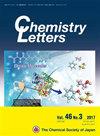通过 PCET 形成酰胺基,利用镍光氧催化酰胺芳基化反应
IF 1.1
4区 化学
Q3 CHEMISTRY, MULTIDISCIPLINARY
引用次数: 0
摘要
在此,我们报告了使用镍-光毒性双催化剂,通过质子耦合电子转移(PCET)形成 N-中心酰胺基,从而实现酰胺的 N-芳基化反应。该反应在温和的条件下实现了受立体阻碍的线性仲酰胺的芳基化。使用自由基抑制剂进行的对照实验表明,酰胺自由基是通过 PCET 机制形成的。本文章由计算机程序翻译,如有差异,请以英文原文为准。
Ni-photoredox-catalyzed amide arylation reaction using amidyl radical formation via PCET
Herein, we report the N-arylation of amides based on the formation of N-centered amidyl radicals via proton-coupled electron transfer (PCET) using a nickel–photoredox dual catalyst. The reaction achieved arylation of sterically hindered linear secondary amides under mild conditions. Control experiments with radical inhibitors suggested the formation of amidyl radicals via the PCET mechanism.
求助全文
通过发布文献求助,成功后即可免费获取论文全文。
去求助
来源期刊

Chemistry Letters
化学-化学综合
CiteScore
3.00
自引率
6.20%
发文量
260
审稿时长
1.2 months
期刊介绍:
Chemistry Letters covers the following topics:
-Organic Chemistry-
Physical Chemistry-
Inorganic Chemistry-
Analytical Chemistry-
Materials Chemistry-
Polymer Chemistry-
Supramolecular Chemistry-
Organometallic Chemistry-
Coordination Chemistry-
Biomolecular Chemistry-
Natural Products and Medicinal Chemistry-
Electrochemistry
 求助内容:
求助内容: 应助结果提醒方式:
应助结果提醒方式:


